 |
| Home │ Audio
Home Page |
Copyright © 2016 by Wayne Stegall
Created December 31, 2016. See Document History at end for
details.
Chebychev Filter Synthesis
Introduction
It is often desirable to design filters of higher than first order to some desirable specification such as flattest frequency response, sharpest cutoff, or linear phase. the last article of this type showed how Butterworth filters were synthesized. Next in order is the Chebychev filter.| Figure 1: Magnitude plot of 2nd order lowpass Chebychev filter. | Figure 2: Magnitude plot of 3rd order lowpass Chebychev filter. |
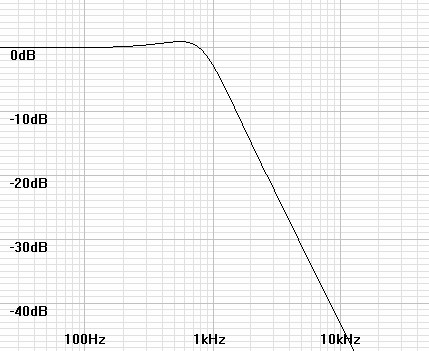 |
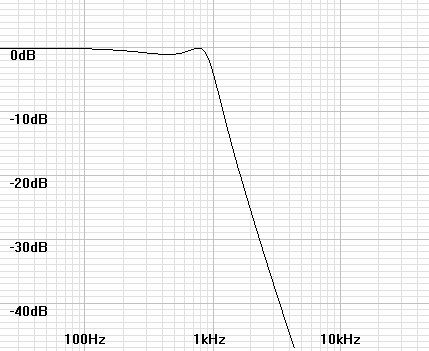 |
Figure 3: Magnitude plot of 4th order lowpass Chebychev filter. |
Figure 4: Magnitude plot of 5th order lowpass Chebychev filter. |
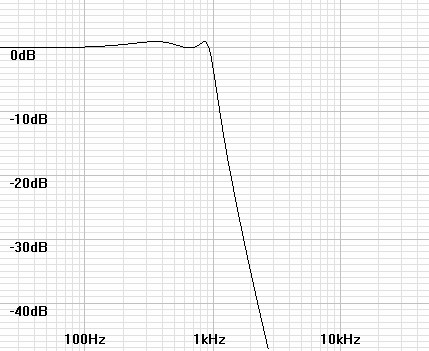 |
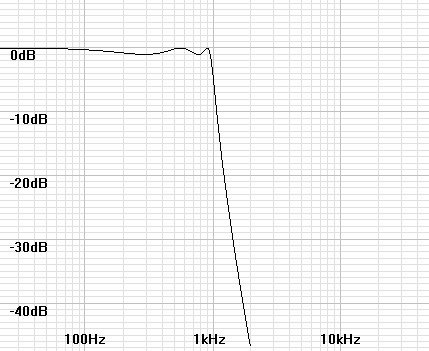 |
Synthesis of poles
Like the Butterworth filter the mathematics for Chebychev synthesis begins with designing a pole plot. First Butterworth poles are created in the left half plane of the s-domain on the unit circle, then altered to an ellipse the multiplying by constants representing the filter specifications. Figures 5-8 show Chebychev pole plots from 2nd to 5th order.| Figure 5: S-domain plot of 2nd order lowpass Chebychev poles. | Figure 6: S-domain plot of 3rd order lowpass Chebychev poles. |
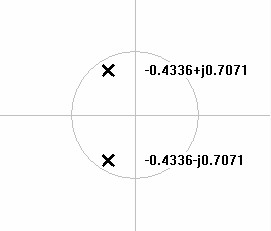 |
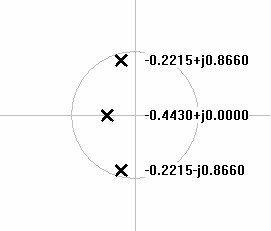 |
| Figure 7: S-domain plot of 4th order lowpass Chebychev poles. | Figure 8: S-domain plot of 5th order lowpass Chebychev poles. |
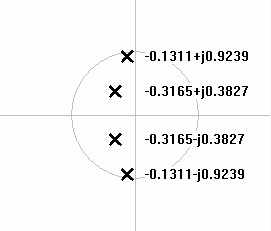 |
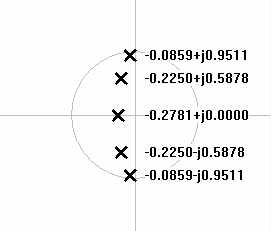 |
First calculate Butterworth poles for the desired order of filter. For N stages i to N the pole angles are calculated by:
| (1) |
θpole-i = 90° + |  |
180° × (2i – 1)
2N |
 |
Here however the angles of the poles is not sufficient. Therefore it is necessary to specify the poles in rectangular complex form.
| (2) |
αi + jβi= cos(θpole-i) + jsin(θpole-i) |
Perform the Chebychev conversion by multiplying the real part of each pole by a constant.
| (3) |
αi' + jβi' = kcheb⋅αi + jβi |
The Chebychev constant is calculated as follows.
| (4) |
ε = | 10decibel-ripple/10 – 1 |
| (5) |
A = | 1
n |
sinh-1 |
1
ε |
| (6) |
kcheb = tanh(A) |
Multiplication by the c alone specifies the design relative to its -3dB point. To specify it by its ripple cutoff, the entire pole must be multiplied by another constant as well.
| (7) |
αi' + jβi' = kripple(kchebαi + jβi) |
Where the constant is calculated as
| (8) |
kripple = cosh(A) |
This is a equivalent to the following calculation.
| (9) |
αi' + jβi' = sinh(A)⋅αi + jcosh(A)⋅βi |
Convert poles to polar form ωi∠θi.
| (10) |
ωi = |αi' + jβi'| = | αi'2 + βi'2 |
| (11) |
θi = tan-1 |  |
βi'
αi' |

|
Highpass transformation
This point the filter is lowpass of frequency 1 rad/s. If a highpass filter is required it is better to do the transform before frequency scaling. For each pole ωi∠θi invert the magnitude around a frequency of 1rad/s as follows.| (12) |
ωi-hp = | 1
ωi-lp |
Deriving stage parameters from pole plot
It remains only to scale the magnitude to the desired frequency and calculate Q from θi.| (13) |
fstage-i = | ωi × f3dB | (if designed relative to
3dB cutoff.) |
| (14) |
fstage-i = | ωi × fripple--cutoff | (if designed relative to
ripple cutoff.) |
It is acceptable to ignore the multiplying of mixed frequency units at this point because the initial frequencies are only relative. It is only when given a complete circuit specified to a certain frequency that units have to be accounted.
| (15) |
Qstage-i = |
1
2|cos(θi)| |
Example
Show synthesis of 5th-order highpass Chebychev at 20Hz.First, calculate pole angles for 5th order lowpass Butterworth filter according to equation 1.
| θpole-1 = 90° + |  |
180° × (2(1) – 1)
2(5) |
 |
| θpole-1 = 90° + |  |
180° × 1
10 |
 |
| θpole-1 = 90° + 18° = 108° |
Continuing as above, each pole is 180/N° or 36° from the previous, thus creating the following sequence of remaining angles.
θpole-2 = 144°, θpole-3 = 180°, θpole-4 = 216°, and θpole-5 = 252°
| Figure 9: Polar plot of 5th order lowpass Butterworth poles |
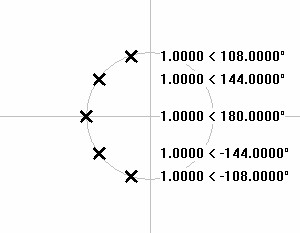 |
Now plot those angles onto the unit circle in rectangular complex form according to equation 2. The first pole calculates:
| αi + jβi = cos(108°) + jsin(108°) = –0.3090 + 0.9511 |
The remaining poles calculate to the values shown in the plot of figure 10 below.
| Figure 10: Rectangular plot of 5th order lowpass Butterworth poles. |
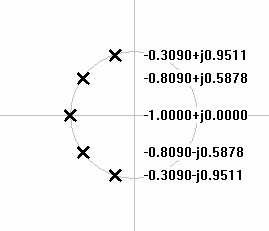 |
Begin the Chebychev transformation by calculating the Chebychev constant per equations 4-6.
| (4) |
ε = | 101dB/10 – 1 | = |
100.1 – 1 | = |
1.258925? – 1 | = |
0.258925 | = 0.508847 |
| (5) |
A = | 1
n |
sinh-1 |
1
ε |
= |
1
5 |
sinh-1 | 1
0.508847 |
= 0.285595 |
| (6) |
kcheb = tanh(0.285595) = 0.278076 |
Multiply the real part of each Butterworth pole by kcheb to give the lowpass Chebychev pole plot.
| Figure 11: Rectangular plot of 5th order lowpass Chebychev poles. |
 |
Convert poles to polar form useful for highpass transformation and calculation of stage parameters by equations 10 and 11.
| Figure 12: Polar plot of 5th order lowpass Chebychev poles. |
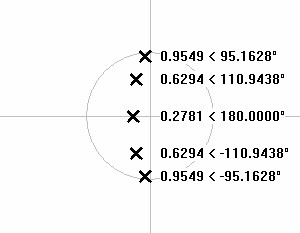 |
Execute highpass transformation by taking the reciprocal of the magnitude of each pole.
| Figure 13: Polar plot of 5th order highpass Chebychev poles. |
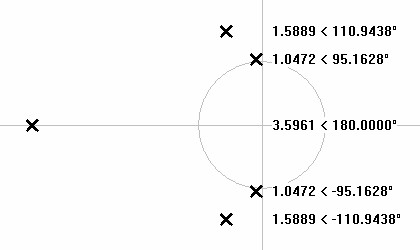 |
Calculate stage parameters from pole values. First scale frequencies from magnitude for pole 1 (representing its conjugate as well)..
| (13) |
fstage-1 = ω1 × f3dB = 1.0472 × 20Hz = 20.944Hz |
Then calculate its Q from its angle.
| (15) |
Qstage-1 = |
1
2|cos(θ1)| |
= |
1
2|cos(95.1628°)| |
= 5.556422 |
Calculations from the remaining poles give a final result.
| Stage |
|
Frequency |
|
Quality Factor |
| 1 |
20.944Hz |
5.556 |
||
| 2 |
31.778Hz |
1.399 |
||
| 3 |
71.9229Hz |
first order |
| Figure
14:
Frequency response of designed filter. |
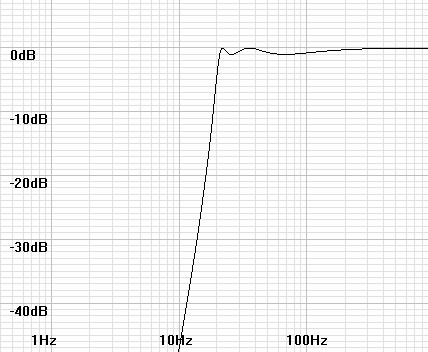 |
Hyperbolic functions
In case your calculator or programming library doe not have hyperbolic
functions these are how they are calculated.| (16) |
sinh(x) = |
ex – e-x
2 |
| (17) |
cosh(x) = |
ex + e-x
2 |
| (18) |
tanh(x) = |
ex – e-x
ex + e-x |
| (19) |
sinh-1(x) = | /ln |
 |
x?+ |
x2 + 1 |
 |
|
|
1The basis for most of the
calculations in this article are from notes taken long ago from (as
best I can remember):
Zverev, A. I., Handbook of Filter
Synthesis, John Wiley and Sons, New York, 1967.
Document History
December 31, 2016 Created.